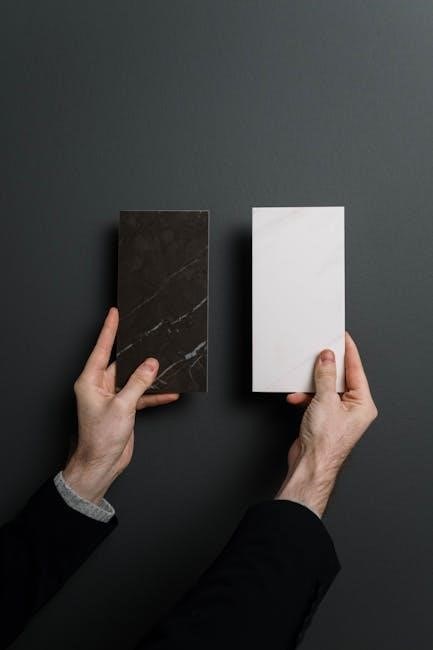PVC Pipe Fittings⁚ An Overview
PVC pipe fittings are essential components used to connect, direct, and control the flow of fluids within plumbing and drainage systems. They are available in a wide variety of shapes and sizes to meet the specific requirements of any project.
Types of PVC Fittings
PVC pipe fittings are essential components used to connect, direct, and control the flow of fluids within plumbing and drainage systems. They are available in a wide variety of shapes and sizes to meet the specific requirements of any project. PVC fittings are categorized by their function and purpose. Some common types include⁚
- Elbows⁚ These fittings are used to change the direction of the pipe flow by 90 degrees or 45 degrees. They come in various angles, including 90-degree elbows, 45-degree elbows, and sweep elbows.
- Tees⁚ Tees are used to branch off a pipe into two different directions. They can be used for creating new connections, splitting flows, or diverting fluids.
- Couplings⁚ Couplings are used to join two pipes together. They are typically used to extend a pipe or to connect two pipes of the same diameter.
- Reducers⁚ Reducers are used to transition between pipes of different diameters. They are used to connect a larger pipe to a smaller pipe or vice versa.
- Caps⁚ Caps are used to seal off the end of a pipe. They are typically used to prevent leaks or to close off a section of pipe that is not in use.
- Bushings⁚ Bushings are used to adapt a pipe to a different size or thread. They are used to connect pipes with different diameters or thread types.
These are just a few examples of the many different types of PVC fittings available. The specific type of fitting that you need will depend on the application and the requirements of your project.
Common PVC Fitting Names
PVC pipe fittings are essential components used to connect, direct, and control the flow of fluids within plumbing and drainage systems. They are available in a wide variety of shapes and sizes to meet the specific requirements of any project. PVC fittings are categorized by their function and purpose. Some common names for PVC fittings include⁚
- 90-degree Elbow⁚ This fitting changes the direction of the pipe flow by 90 degrees.
- 45-degree Elbow⁚ This fitting changes the direction of the pipe flow by 45 degrees.
- Sweep Elbow⁚ This fitting provides a gradual change in direction, reducing flow turbulence.
- Tee⁚ This fitting creates a branch off a pipe, allowing for two different flow directions.
- Wye⁚ Similar to a tee but with a wider angle for the branch, often used for drainage systems.
- Coupling⁚ This fitting joins two pipes of the same diameter together.
- Reducer⁚ This fitting connects pipes of different diameters, transitioning from a larger to a smaller pipe.
- Cap⁚ This fitting seals off the end of a pipe, preventing leaks or closing off unused sections.
- Bushing⁚ This fitting adapts a pipe to a different size or thread type, connecting pipes with varying diameters or threads.
Understanding these common names will help you navigate the world of PVC fittings and select the appropriate components for your projects.
PVC Fitting Applications
PVC pipe fittings are versatile components used in a wide range of applications, both residential and commercial. They are commonly used in plumbing, drainage, irrigation, and industrial settings. PVC fittings are known for their durability, resistance to corrosion, and ease of installation, making them a popular choice for various projects.
- Plumbing Systems⁚ PVC fittings are widely used in residential and commercial plumbing systems for water supply, waste disposal, and drainage. They are suitable for hot and cold water lines, as well as for connecting sinks, toilets, showers, and other fixtures.
- Drainage Systems⁚ PVC fittings are ideal for drainage systems, including storm drains, sewer lines, and underground piping. They are resistant to chemicals and harsh environments, making them suitable for handling wastewater.
- Irrigation Systems⁚ PVC fittings are commonly used in irrigation systems for transporting water to crops and landscaping. They are durable, lightweight, and resistant to corrosion, making them a reliable choice for outdoor applications.
- Industrial Applications⁚ PVC fittings are also used in industrial settings for handling chemicals, fluids, and gases. Their resistance to chemicals and corrosion makes them suitable for various industrial processes.
The versatility of PVC fittings makes them a valuable asset in various construction and industrial projects.
PVC Fitting Materials
PVC pipe fittings are primarily made from polyvinyl chloride (PVC), a durable and versatile thermoplastic material. PVC is known for its excellent resistance to corrosion, chemicals, and UV radiation, making it suitable for various applications. However, depending on the specific application and requirements, PVC fittings may also incorporate other materials to enhance their performance and durability.
- Unplasticized PVC (uPVC)⁚ This type of PVC is rigid and strong, making it ideal for pressure pipes and fittings. It is commonly used in plumbing, drainage, and irrigation systems.
- Chlorinated Polyvinyl Chloride (CPVC)⁚ CPVC is a modified form of PVC with enhanced resistance to high temperatures. It is commonly used for hot water systems and plumbing applications where high temperatures are involved.
- Reinforced PVC⁚ PVC fittings can be reinforced with fiberglass or other materials to increase their strength and rigidity. This type of fitting is often used in high-pressure applications or where structural integrity is critical.
- PVC with Additives⁚ PVC fittings can be formulated with additives to enhance their properties. These additives can improve their resistance to UV radiation, impact, or chemicals.
The choice of PVC material for fittings depends on the specific application, environmental conditions, and performance requirements.
PVC Fitting Standards and Certifications
To ensure safety, quality, and compatibility, PVC pipe fittings are subject to various standards and certifications. These standards define the materials, dimensions, performance requirements, and testing procedures for PVC fittings. Some of the common standards and certifications include⁚
- ASTM International (ASTM)⁚ ASTM is a global organization that develops and publishes technical standards for various materials, including PVC. ASTM standards for PVC fittings specify material requirements, dimensions, pressure ratings, and testing methods.
- ANSI (American National Standards Institute)⁚ ANSI is a private non-profit organization that coordinates the development of voluntary consensus standards in the United States. ANSI standards for PVC fittings ensure compatibility and interchangeability between products from different manufacturers.
- UL (Underwriters Laboratories)⁚ UL is a global safety science company that tests and certifies products to meet safety standards. UL certification for PVC fittings indicates that they have met safety requirements for electrical and fire hazards.
- NSF International (NSF)⁚ NSF is a public health and safety organization that develops and certifies products to meet standards for public health and safety. NSF certification for PVC fittings indicates that they are safe for use in potable water systems.
By adhering to these standards and certifications, manufacturers ensure that their PVC fittings meet the required performance and safety standards, making them reliable and trustworthy for use in various applications.
PVC Pipe Fitting Installation
Installing PVC pipe fittings requires proper preparation, tools, and techniques to ensure a secure and leak-free connection.
Cutting PVC Pipe
Cutting PVC pipe accurately and cleanly is crucial for a successful installation. A sharp utility knife or a dedicated PVC pipe cutter are the most common tools used. When using a utility knife, score the pipe deeply with a single, firm stroke. Then, carefully snap the pipe along the score line. A pipe cutter offers a more precise cut and avoids the risk of crushing the pipe.
Before cutting, measure the pipe carefully to ensure an accurate length. Mark the cut line with a permanent marker for clear visibility. When cutting, use a steady hand and avoid twisting or bending the pipe to prevent uneven cuts. For a clean finish, use a deburring tool to remove any sharp edges along the cut.
Remember, a clean, straight cut is essential for a secure and leak-proof connection with PVC fittings.
Joining PVC Pipe
Joining PVC pipe sections together is typically achieved through solvent welding, a process that creates a strong, permanent bond. This method involves applying a solvent cement to the mating surfaces of the pipe and fitting, which dissolves the PVC slightly, creating a chemical fusion.
Before joining, ensure that the pipe ends are clean, dry, and free of debris. Apply a thin, even coat of solvent cement to both surfaces, paying attention to the inside of the fitting. Immediately insert the pipe into the fitting, rotating it slightly to ensure full contact.
Hold the pipe and fitting together for the recommended dwell time, allowing the solvent to evaporate and the bond to solidify. Avoid moving or disturbing the joint during this period. Once the bond is set, the joint will be strong and leak-proof.
PVC Fitting Maintenance
PVC fittings, due to their durable and corrosion-resistant nature, generally require minimal maintenance. However, regular inspections and cleaning can help ensure optimal performance and longevity.
Visually inspect the fittings for any signs of damage, cracks, or leaks. Check for any buildup of sediment or debris that could restrict water flow. Clean any accumulated dirt or grime with a mild detergent and water, ensuring the fittings are thoroughly rinsed afterward.
If you encounter any issues, such as leaks or cracks, it’s important to address them promptly. Replace damaged fittings with new ones to maintain the integrity of your plumbing system. Proper maintenance practices will ensure your PVC fittings continue to function reliably for years to come.

PVC Pipe Fittings Resources
For comprehensive information on PVC pipe fittings, various resources are available online, including manufacturer websites, image libraries, and downloadable PDFs.
Online Retailers
Numerous online retailers specialize in supplying PVC pipe fittings, offering a wide selection of products to meet various plumbing and drainage needs. These retailers often provide detailed product information, including specifications, images, and customer reviews, making it easy for customers to choose the right fittings for their projects. Some popular online retailers that offer PVC pipe fittings include Amazon, Home Depot, Lowe’s, and Grainger Industrial Supply. These platforms provide a convenient and accessible way to purchase fittings, with options for delivery or in-store pickup.
Manufacturer Websites
Visiting manufacturer websites is a valuable resource for obtaining comprehensive information about PVC pipe fittings. Manufacturers often provide detailed technical specifications, installation guides, and downloadable resources, such as PDF catalogs and image libraries. These websites are also a reliable source for product warranties, certifications, and contact information. Some prominent PVC pipe fitting manufacturers include JM Eagle, Charlotte Pipe and Foundry, Apollo Pipes Ltd., and ASAHI YUKIZAI CORPORATION. By exploring these websites, customers can gain a deeper understanding of the products, their applications, and the company’s commitment to quality and sustainability.
PDF Downloads
PDF downloads offer a convenient way to access comprehensive information about PVC pipe fittings. Manufacturers, suppliers, and industry associations often provide PDF catalogs, technical manuals, and installation guides that can be easily downloaded and saved for future reference. These PDF documents typically include detailed product specifications, dimensional drawings, material properties, and installation instructions. They also provide valuable insights into the different types of PVC pipe fittings available, their applications, and industry standards. By downloading these PDFs, users can readily access a wealth of information to make informed decisions about their PVC pipe fitting needs.




Be the first to reply